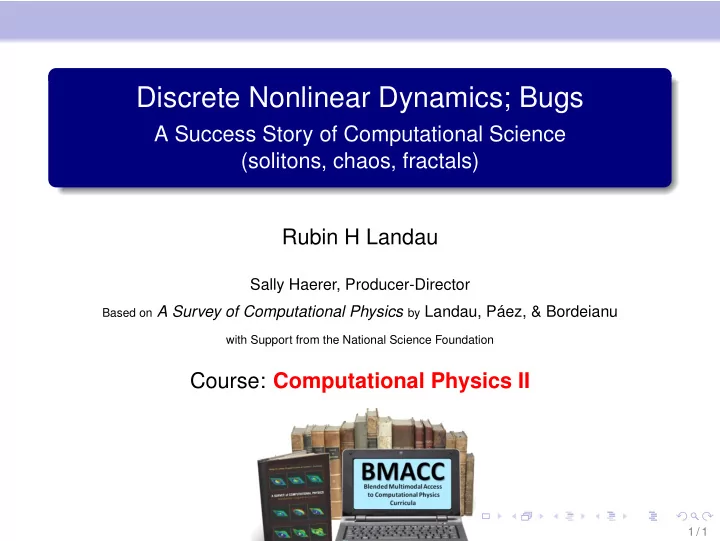

Discrete Nonlinear Dynamics; Bugs A Success Story of Computational Science (solitons, chaos, fractals) Rubin H Landau Sally Haerer, Producer-Director Based on A Survey of Computational Physics by Landau, Páez, & Bordeianu with Support from the National Science Foundation Course: Computational Physics II 1 / 1
Problem: Why Is Nature So Complicated? Insect populations, weather patterns Complex behavior Stable, periodic, chaotic, stable, . . . Problem: can a simple, discrete law produce such complicated behavior? 2 / 1
Model Realistic Problem: Bug Cycles Bugs Reproduce Generation after Generation = i N 0 → N 1 , N 2 , . . . N ∞ N i = f ( i )? Seen discrete law, ∆ N ∆ t = − λ N ⇒ ≃ e − λ t − λ → + λ ⇒ growth 3 / 1
Refine Model: Maximum Population N ∗ Incorporate Carrying Capacity into Rate Assume breeding rate proportional to number of bugs: ∆ N i ∆ t = λ N i Want growth rate ↓ as N i → N ∗ Assume λ = λ ′ ( N ∗ − N i ) ∆ N i ∆ t = λ ′ ( N ∗ − N i ) N i ⇒ (Logistic Map) Small N i / N ∗ ⇒ exponential growth N i → N ∗ ⇒ slow growth, stable, decay 4 / 1
Logistic as Map in Dimensionless Variables As Population, Change Variables N i + 1 = N i + λ ′ ∆ t ( N ∗ − N i ) N i (1) x i + 1 = µ x i ( 1 − x i ) (Logistic Map) (2) = λ ′ ∆ t N i ≃ N i = 1 + λ ′ ∆ tN ∗ , µ def def x i (3) µ N ∗ x i ≃ N i = fraction of max (4) N ∗ 0 ≤ x i ≤ 1 Quadratic, 1-D map Map: x i + 1 = f ( x i ) f ( x ) = µ x ( 1 − x ) 5 / 1
10 B D 20 10 0 C 20 n 0 20 n 10 0 A 0.8 0.4 0 20 10 0 x n Properties of Nonlinear Maps (Theory) Empirical Study: Plot x i vs i A: µ = 2.8 , equilibration into single population B: µ = 3.3 , oscillation between 2 population levels C: µ = 3.5 oscillation among 4 levels D: chaos 6 / 1
0 B D 20 10 n C 20 10 0 20 n 10 0 A 0.8 0.4 0 20 10 0 x n Fixed Points x i Stays at x ∗ or Returns x i + 1 = µ x i ( 1 − x i ) (5) One-cycle: x i + 1 = x i = x ∗ µ x ∗ ( 1 − x ∗ ) = x ∗ (6) x ∗ = µ − 1 ⇒ x ∗ = 0 , (7) µ 7 / 1
C B D 20 10 0 n 20 10 0 20 n 10 0 A 0.8 0.4 0 20 10 0 x n Period Doubling, Attractors Unstable via Bifurcation into 2-Cycle Attractors, cycle points Predict: same population generation i , i + 2 � µ 2 − 2 µ − 3 x i = x i + 2 = µ x i + 1 ( 1 − x i + 1 ) ⇒ x ∗ = 1 + µ ± 2 µ µ > 3: real solutions Continues 1 → 2 populations 8 / 1
Exercise 1 Produce sequence x i Confirm behavior patterns A, B, C, D 1 Identify the following: 2 Transients Asymptotes Extinction Stable states Multiple cycles Four-cycle Intermittency 3 . 8264 < µ < 3 . 8304 Chaos deterministic irregularity; hypersensitivity ⇒ nonpredictable, µ = 4 , 4 ( 1 − ǫ ) 9 / 1
1.0 x* 1.0 2.0 3.0 4.0 0.0 0.2 0.4 0.6 0.8 µ Bifurcation Diagram (Assessment) Concentrate on Attractors Simplicity in chaos Attractors as f ( µ ) Scan x 0 , µ Let transients die Output ( µ, x ∗ ) s n cycle = n values See enlargements 10 / 1
Detailed Bifurcation Diagram 11 / 1
4.0 0.4 µ x* 1.0 0.8 1.0 2.0 3.0 0.6 0.0 0.2 Bifurcation Diagram Sonification Play Bifurcation Diagram ω ∝ x ∗ Hear each bifurcation Bifurcation = new ω , cord Each branch = one ω 12 / 1
µ 1.0 2.0 3.0 4.0 0.0 0.2 0.4 0.6 0.8 1.0 x* Exercise 2: Bifurcation Diagram Can’t vary intensity Vary point density Resolution ∼ 300 DPI 3000 × 3000 ≃ 10 7 pts Big, more = waste Create 1000 bins 1 ≤ µ ≤ 4 Print x ∗ 3-4 decimal places Remove duplicates Enlarge: self-similarity Observe windows 13 / 1
Summary & Conclusion Simplicity & Beauty within Chaos Yes, simple discrete maps can lead to complexity Models of real world complexity Complexity related to nonlinearity ( x 2 ) Computation crucial for nonlinear systems Signals of simplicity, chaos Bifurcation Diagram Feigenbaum Constants Lyapunov Coefficients Shannon Entropy Fractal Dimension 14 / 1
Recommend
More recommend